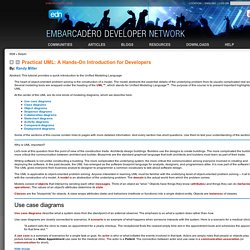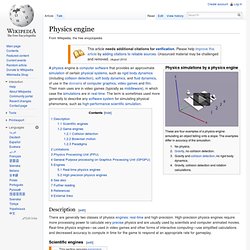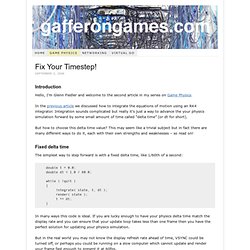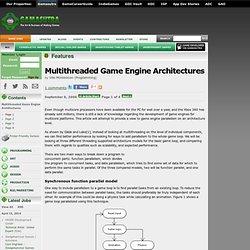

Design Patterns. Practical UML: A Hands-On Introduction for Developers. The heart of object-oriented problem solving is the construction of a model.

The model abstracts the essential details of the underlying problem from its usually complicated real world. Several modeling tools are wrapped under the heading of the UML™, which stands for Unified Modeling Language™. Software design. This article is about the activity between requirements and programming.

For the broader meaning, see software development. Software design usually involves problem solving and planning a software solution. This includes both low-level component and algorithm design and high-level, architecture design. Overview[edit] Software design can be considered as creating a solution to a problem in hand with available capabilities. When designing software, two important factors to consider are its security and usability. Game programming. This article is about the specifics of the programming aspect of video game development, for a broader overview see video game development.

Development process[edit] Prototyping[edit] Programmers are often required to produce prototypes of gameplay ideas and features. A great deal of prototyping may take place during pre-production, before the design document is complete, and may help determine what features the design specifies. Video game development. Video game development is the process of creating a video game.

Development is undertaken by a game developer, which may range from a single person to a large business. Traditional commercial PC and console games are normally funded by a publisher and take several years to develop. Indie games can take less time and can be produced cheaply by individuals and small developers. Physics engine. A physics engine is computer software that provides an approximate simulation of certain physical systems, such as rigid body dynamics (including collision detection), soft body dynamics, and fluid dynamics, of use in the domains of computer graphics, video games and film.

Their main uses are in video games (typically as middleware), in which case the simulations are in real-time. The term is sometimes used more generally to describe any software system for simulating physical phenomena, such as high-performance scientific simulation. Description[edit] There are generally two classes of physics engines: real-time and high-precision.
High-precision physics engines require more processing power to calculate very precise physics and are usually used by scientists and computer animated movies. Scientific engines[edit] One of the first general purpose computers, ENIAC, was used as a very simple type of physics engine. Engine - Tips for writing the main game loop. DeWiTTERS Game Loop – Koonsolo Games. The game loop is the heartbeat of every game, no game can run without it.

But unfortunately for every new game programmer, there aren’t any good articles on the internet who provide the proper information on this topic. But fear not, because you have just stumbled upon the one and only article that gives the game loop the attention it deserves. Thanks to my job as a game programmer, I come into contact with a lot of code for small mobile games. And it always amazes me how many game loop implementations are out there. You might wonder yourself how a simple thing like that can be written in different ways. (Thanks to Kao Cardoso Félix this article is also available in Brazilian Portuguese, and thanks to Damian/MORT in Polish) Fix Your Timestep! Introduction Hello, I’m Glenn Fiedler and welcome to the second article in my series on Game Physics.

In the previous article we discussed how to integrate the equations of motion using an RK4 integrator. Integration sounds complicated but really it’s just a way to advance the your physics simulation forward by some small amount of time called “delta time” (or dt for short). But how to choose this delta time value? This may seem like a trivial subject but in fact there are many different ways to do it, each with their own strengths and weaknesses – so read on! Features - Multithreaded Game Engine Architectures. Even though multicore processors have been available for the PC for well over a year, and the Xbox 360 has already sold millions, there is still a lack of knowledge regarding the development of game engines for multicore platforms.

This article will attempt to provide a view to game engine parallelism on an architecture level. As shown by Gabb and Lake[1], instead of looking at multithreading on the level of individual components, we can find better performance by looking for ways to add parallelism to the whole game loop. We will be looking at three different threading supported architecture models for the basic game loop, and comparing them with regards to qualities such as scalability, and expected performance. There are two main ways to break down a program to concurrent parts: function parallelism, which divides the program to concurrent tasks, and data parallelism, which tries to find some set of data for which to perform the same tasks in parallel.
Figure 1. Multi-core Processors. This article originally appeared in the "Inner Product" column in Game Developer Magazine, February 2006 Next generation game platforms are increasingly making use of multiple processors to deliver more computing power.

The Xbox 360 has three symmetrical CPUs running two hardware thread each. The PS3 has one master CPU with seven separate "SPE" processors. The Nintendo Revolution is probably dual threaded. Newer gaming PCs have dual core hyper-threaded processors. Programmers who were used to programming for a single core are now increasing faced with the challenge of translating their programming skills to a multi-core system. The simplest option is to just ignore the additional CPU resources, and run all your code from a single thread on a single CPU. All the examples will use this simplified version of the systems in a game engine. Here the flow of execution is very straightforward. C++ - Several classes need to access the same data, where should the data be declared. Glenn Fiedler. Game Development + Game Programming Tutorials.